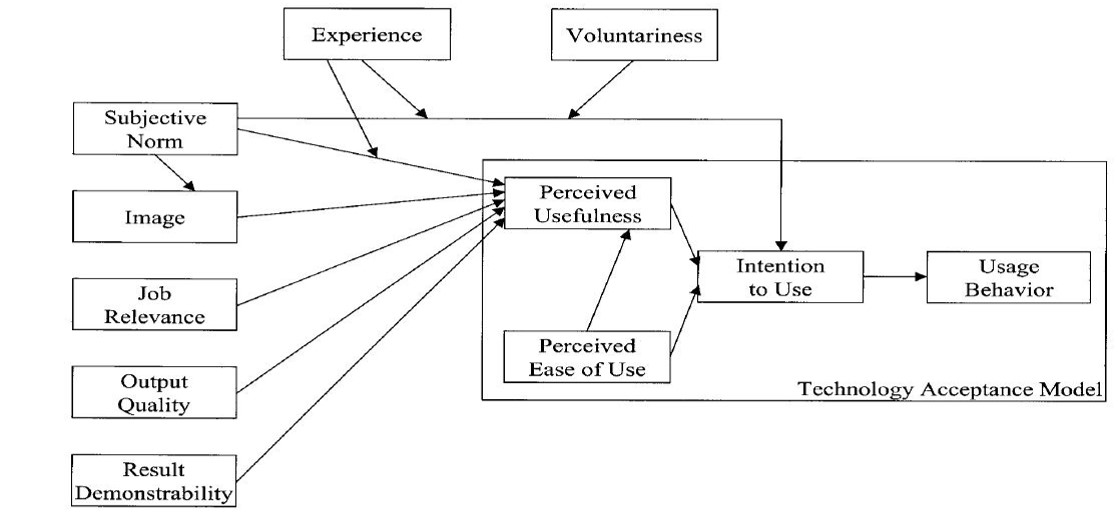Technology Acceptance Model
The Technology Acceptance Model (TAM) (Davis, 1989) is based on the theory of reasoned action and information systems models that explain how users come to accept the use of a particular technology.
The model suggests that when users are presented with a new technology, several factors influence their decision about how and when to use it. Although TAM is one of the most influential models used in technology acceptance studies and has been empirically proven to have high validity, it should be used with some degree of caution, as with the internationalization of businesses, there is an increasing need to understand how cultural factors can affect a multinational organization’s ability to adopt and use information technology.
This model was developed to explain an individual's decision-making process through critical technological factors for accepting new information systems technologies in an organizational context (Davis, 1989). The technology acceptance model thesis explains two things. Firstly, that external variables will influence the perceived ease of use and usefulness of a technology, and secondly, that the perceived ease of use of a technology will have a direct effect on its perceived usefulness.
The amount of information flowing through computerized systems today is so vast that it is difficult to manipulate this information without the help of technology, but according to Davis (1989), you will not make a technically high-performance information system if, for some reason, you do not adopt and accept the available technology.
Indeed, in recent years sponsored advertising has generated strong advertising revenues for platforms such as Facebook. Sponsored ads are built on an interactive platform. However, they are arguably intrusive to the privacy of users. But there is little research on how users react to these ads. A study is therefore needed to assess the effects of user perceptions of privacy risks and the usefulness of sponsored advertising on consumer attitudes and purchase intention. Testing a model derived from the Technology Acceptance Model (TAM), the study found that privacy concerns and intrusiveness are both valid antecedents to perceived usefulness but not to perceived ease of use of sponsored advertising. Although both antecedent variables also influence consumer attitudes towards sponsored advertising.

Figure 1: Technology Acceptance Model
The model considers that many external variables explain this perceived usefulness and perceived ease of use (e.g., the user, the organization, the technical system) and it is also considered that ease of use can influence perceived usefulness. Richard Bagozzi (2008), one of the original authors of the GAT, also argues for the extension of the theoretical bases, which are far too limited: for him, it is necessary to consider the cognitive processes linked to emotions and self-regulation capacities. He says that a desire for action functions as an essential mediator between the many reasons for action on the one hand and the desire to act on the other.

Figure 2: TAM 2- Extension of the Technology Acceptance Model
Early research showed the effectiveness of Facebook advertising by examining the interaction between SNS users who shared information about brands or products (Yang, 2012). Other work has also investigated the results of advertising methods based on the ratio of the number of 'likes' on Facebook ads and the size of the 'followers' on Twitter on brand image and whether products are sold more when a person known and liked by the public advertises them through the networks and new technologies.
The participants in the study were recruited from undergraduate students at a major university in the Northeast. According to the research, younger, college-aged users are more influenced by Facebook advertising than other age groups. This is because they are younger and therefore more susceptible to influence and, above all, this is an age group that uses social networks a lot (e.g., Lin & Kim, 2016). They can also be referred to as 'digital natives', they also do not have the same privacy concerns that may influence their use of social media.
Consumers have doubts about online privacy, according to researchers this fear of intrusion is a negative aspect of new media development. Technology helps in many areas, with many applications making our daily lives easier. For example, consumers like to be able to consult their bank account online and have a positive attitude towards this technology. Even if they do not see it as an invasion of their privacy. But digital banking benefits customers and enables banks to improve and accelerate the delivery of financial products and reduce transactional costs, thereby increasing profitability, saving costs and providing a better overall service to their customers (Dash et al., 2011). Intrusion is seen as an aspect of privacy in e-commerce (Morimoto & Macias, 2009). In this study, an online survey examined how two aspects of privacy, perceived intrusiveness and psychological reactance, influenced consumers' attitudes towards unsolicited commercial e-mail and marketing in general. The results indicate that the more intrusive an email is perceived to be, the stronger the reactance against it, the more likely it is to be avoided and the more negative the attitudes towards it.
It should be noted that this study is one of the first to examine GAT in the context of consumer acceptance of social media advertising as an interactive technological innovation and a new advertising venue. The results of the study show that TAM is still able to successfully explain the relationship between privacy concerns, intrusion concerns and the use of social media.